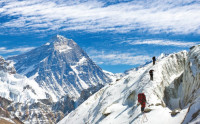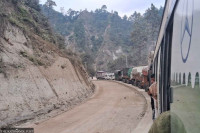Opinion
Megalopolis 2.0
While Nepal struggles to manage mass commutes, some countries are leapfrogging to smart vehicles
Manish Pokharel & Bimal Pratap Shah
The tiny city-state of Singapore, known for clean air, thriving economy, good governance, and radical innovations, recently made headlines by becoming the first country in the world to offer self-driving taxi services. We believe, all of us are waiting for the day when we can say the same about the Kathmandu Valley, which has now become synonymous with overpopulation, sluggish economic growth, poverty, and pollution. If the government of Nepal does not come up with concrete plans to do something with immediate effect to manage the basic needs of the growing population, the valley is sure to invite a crisis of immense proportion in the days to come.
World population growth is most rapidly happening in the developing world where the majority of the world’s 1.2 billion poverty-stricken people live. Thus, most of the problems faced by developing nations today are in one way or the other driven by the government’s inability to meet the demands of the exploding population—many fail to ensure adequate food, water, health care, shelter, education, electricity, and employment. Nepal’s situation is no better because one in four people in the country live below the national poverty line which is less than a dollar per day.
Population and pollution
Population growth tends to increase the number of hungry people in the world. Two decades ago, there were 800 million hungry people on the planet. Around that time, the world leaders, mainly from the first world countries, pledged to reduce the number of chronically starving to half by 2015. Unfortunately, the target was never reached. As of 2016, the world population has reached 7.4 billion and the number of chronically famished has increased to a billion—20 percent more than in 1996. A close to a million people in Nepal are in need of food assistance and the number is likely to grow with the surge in population.
Nepal’s population, with the annual growth rate of 1.35 percent, stood at 27.8 million in 2013. The Kathmandu Valley with a growth rate of 4.63 percent accounts for 24 percent of total urban population in the country, making it one of the fastest growing urban agglomerations in South Asia. Research findings show that the population growth in poorly managed countries tend to be extremely polluted due to a surge in the number of vehicles. And that could be why the valley has become the third most polluted megalopolis in the world.
The big fossil fuel guzzling automobiles are one of the main contributors to the valley’s pollution nightmare. This is because many of its inhabitants consider big vehicles to be a symbol of wealth. So, it will be necessary to get them out of their status symbols and onto greener transportation, if the valley of pollution is to be converted into a valley of clean air. This, however, seems impossiblebecause the government is neither serious about promoting electric vehicles and bicycles, nor about having a good public transport system. And the government does not seem to be planning anything revolutionary either.
Perils of communiting
If the government is serious, it should start planning to convert the valley into smart cities in which people prefer public transportation where and when possible because of the excellent urban transport systems that are fast, safe, clean affordable and easy to use. Furthermore, a common ticket or fare card serving all systems allows commuters to seamlessly transfer from one mode to the other.
While Nepal is struggling to manage the valley’s mass commutes, other countries are leapfrogging to the world of smart vehicles. nuTonomy, founded by two Singaporean researchers from the Massachusetts Institute of Technology, became the first company in the world to offer rides in self-driving cars on city streets of the Lion City. The Singapore government provided financial as well as bureaucratic support for the startup to launch self-driving taxi services before anyone else. Singapore gets innovative startups due to the country’s startup friendly policies and regulatory reforms that are frequently updated to make them relevant with time. As for Nepal, the country needs to drop policies suited for the last century and embrace the ones designed for the 21st century.
In the US, the home of Silicon Valley, Pittsburg is the first city to allow self-driving taxis on the streets. Uber rolled out passenger ready self-driving vehicles in the Steel City this month. Regular Uber users will be randomly assigned to one of the Volvo Sports Utility Vehicle (SUV). The SUVs, however, will not be fully autonomous for now. There will be a back-up human driver at the steering wheel to comply with the Pennsylvania state law and a co-pilot will also be present to collect data for analysis. The Singaporean startup is now eyeing the US market and plans to compete with Uber in the Iron City before the year ends.
Aim for the sky
Even though, Nepal is nowhere close to Singapore or the US when it comes to investing in innovative projects to benefit the population, our policymakers have to build world-class startup ecosystems so as to give rise to startups that can solve many of the problems faced by the impoverished nation of ours. But, for this to happen, the government needs to start thinking like startups and not a government agency of the last century—it has to be agile, get things done at the speed of thought, and start funding innovative projects.
At this point in time, there is no way self driving cars can navigate the unscientific roads of the Kathmandu Valley. Still, the government has to prioritise self driving vehicles so that the Megalopolis can free itself from rude, uncouth, and hooligan-like drivers, not to mention non-stop honking, traffic congestion, high beaming, pollution, and reckless motorcycle riding.
Pokharel is Head of the Department of Computer Science and Engineering at Kathmandu University; Shah is the co-author of ‘Strategic IT Planning for Public Organizations: A Toolkit’ published by the United Nations University-International Insitute for Software Technology in 2009




 13.05°C Kathmandu
13.05°C Kathmandu












